Prayer plants are beautiful indoor plants that are known for their vibrant foliage and unique patterns. However, like all living things, prayer plants can become sick and start to wither away. If you notice your prayer plant is dying, don’t worry. There are several things you can do to revive it and bring it back to life.
Understanding prayer plants is essential to save a dying prayer plant. Prayer plants are native to tropical regions and prefer warm, humid environments. They get their name from the way their leaves fold up at night, resembling praying hands.
Prayer plants are relatively easy to care for, but they do have specific needs, such as proper lighting, watering, and humidity levels. If you notice your prayer plant is dying, it’s essential to identify the signs and causes to determine the best course of action to save it.
Key Takeaways:
- Understanding the needs of prayer plants is essential to reviving a dying plant.
- Identifying signs of a dying prayer plant is crucial to determine the best course of action.
- Proper care and maintenance can help prevent a prayer plant from dying.
Similar posts:
Understanding Prayer Plants
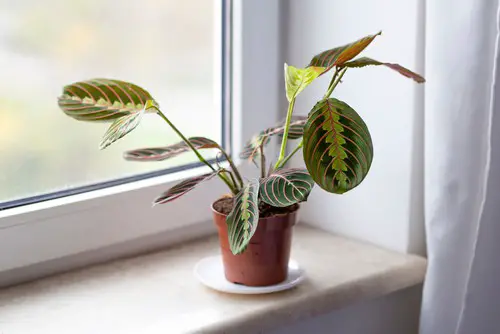
Prayer plants, also known as Maranta leuconeura or Aranta leuconeura, are a popular houseplant choice due to their beautiful foliage and ease of care. These tropical plants are native to the rainforests of Brazil and thrive in warm, humid environments.
One of the most distinctive features of prayer plants is their leaves, which are often variegated with shades of green, red, and purple. The leaves also have a unique folding pattern, which gives the plant its common name. At night, the leaves fold up and resemble hands in prayer, hence the name “prayer plant.”
Prayer plants are relatively easy to care for, but they do have specific needs that must be met to ensure their health and longevity. They prefer bright, indirect light and should be kept away from direct sunlight, which can scorch their leaves.
They also require consistently moist soil, but overwatering can lead to root rot and other fungal diseases, which can be fatal to the plant.
In addition to proper lighting and watering, prayer plants also benefit from high humidity levels. This can be achieved by placing a humidifier near the plant or by misting it with water regularly. They also prefer temperatures between 65-75°F (18-24°C), making them an ideal indoor plant for most homes.
Identifying Signs of a Dying Prayer Plant
When it comes to saving a dying prayer plant, identifying the signs of distress is the first step. Here are some common signs to look out for:
1. Yellow Leaves
Yellowing leaves are a common sign of a dying prayer plant. This can be caused by overwatering, underwatering, or lack of nutrients. If the yellowing is widespread, it may be a sign of root rot, which can be fatal to the plant.
2. Brown Leaves
Brown leaves are another sign that your prayer plant is in distress. This can be caused by a variety of factors, including overwatering, underwatering, or exposure to direct sunlight. Brown leaves may also be a sign of pest infestation or disease.
3. Drooping Foliage
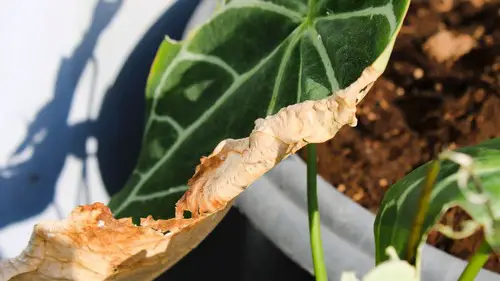
If your prayer plant’s leaves are drooping, it may be a sign of underwatering or overwatering. In some cases, drooping foliage can also be a sign of root rot or pest infestation.
4. Leggy Growth
Leggy growth is a term used to describe a plant that has long, thin stems with few leaves. This can be caused by a lack of light, overwatering, or poor soil quality. In some cases, leggy growth may be a sign of nutrient deficiency.
5. Loss of Luster
If your prayer plant’s leaves are losing their luster and becoming dull, it may be a sign of nutrient deficiency or pest infestation. In some cases, loss of luster may also be a sign of overwatering or exposure to direct sunlight.
Remember, identifying the signs of a dying prayer plant is the first step in saving your plant. Once you have identified the problem, you can take steps to address it and nurse your plant back to health.
Causes of a Dying Prayer Plant
Prayer plants are known for their beautiful foliage and ability to thrive in low light conditions. However, even the most experienced plant owners can encounter issues with their prayer plant. Here are some of the most common causes of a dying prayer plant:
1. Overwatering
Overwatering is a common cause of a dying prayer plant. These plants prefer moist soil, but too much water can lead to root rot and other issues. Signs of overwatering include yellowing leaves, wilting, and a damp or musty smell coming from the soil.
To prevent overwatering, make sure the soil is well-draining and allow the top inch of soil to dry out before watering again.
2. Underwatering
On the other hand, underwatering can also cause a prayer plant to die. Signs of underwatering include brown, crispy leaves and soil that is dry to the touch. To prevent underwatering, make sure the soil is consistently moist but not waterlogged. Water the plant when the top inch of soil feels dry.
3. Low Humidity
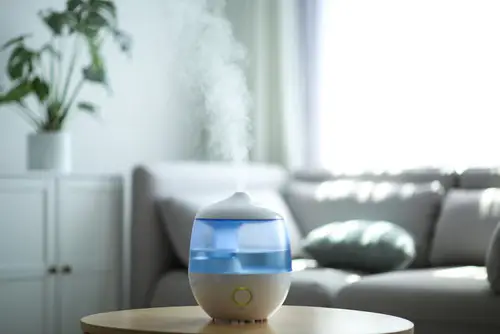
Prayer plants prefer high humidity levels, and low humidity can cause the leaves to dry out and turn brown. To increase humidity, consider using a humidifier, placing a tray of water near the plant, or misting the leaves regularly.
4. Improper Lighting
Prayer plants prefer bright, indirect light. Direct sunlight can scorch the leaves, while too little light can cause the plant to become leggy and weak. If the plant is not receiving enough light, consider moving it to a brighter location or supplementing with artificial light.
5. Pest Infestation
Mealybugs and spider mites are common pests that can infest prayer plants. These pests can cause leaves to yellow and fall off, and can even kill the plant if left untreated. To prevent infestations, regularly inspect the plant for pests and treat with insecticidal soap if necessary.
6. Poor Soil Quality
Prayer plants prefer well-draining soil that is rich in organic matter. Poor soil quality can cause the plant to become stressed and more susceptible to disease and pests. Consider repotting the plant in fresh, high-quality potting soil to improve its health.
By addressing these common causes of a dying prayer plant, plant owners can help their prayer plants thrive and flourish.
Reviving a Dying Prayer Plant
Prayer plants are beautiful foliage plants that can add a touch of greenery to any indoor space. However, sometimes they can start to look a little sad and droopy. If you notice your prayer plant is dying, don’t worry – there are steps you can take to revive it. In this section, we will cover the most effective ways to revive a dying prayer plant.
1. Proper Watering
Overwatering is one of the most common reasons why prayer plants die. When the soil is constantly wet, it can lead to root rot, which can be fatal for your plant. On the other hand, underwatering can also cause your prayer plant to wilt and die. The key is to find the right balance.
To properly water your prayer plant, wait until the top inch of soil is dry before watering it thoroughly. Make sure the pot has drainage holes to allow excess water to escape. Avoid letting the pot sit in standing water, as this can also lead to root rot.
2. Increasing Humidity
Prayer plants prefer high humidity levels, so if the air in your home is dry, your plant may start to suffer. To increase humidity levels, you can mist your plant regularly or place a tray of water near it. You can also use a humidifier to keep the air moist.
3. Correct Lighting
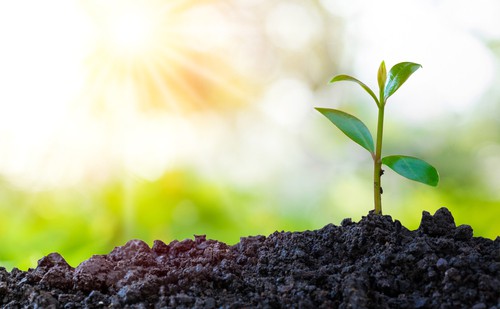
Prayer plants prefer bright, indirect light. If your plant is not getting enough light, it may start to wilt and die. However, direct sunlight can be too harsh for the delicate leaves of a prayer plant. If your plant is not getting enough light, try moving it to a brighter location, but avoid placing it in direct sunlight.
4. Dealing with Pests
Pests like spider mites and mealybugs can also cause your prayer plant to die. If you notice any signs of pests, such as webbing or sticky residue, you should take action immediately. You can use neem oil or insecticidal soap to get rid of pests.
5. Repotting
If your prayer plant is still struggling after trying the above steps, it may be time to repot it. Over time, the soil in your plant’s pot can become compacted and lose its ability to hold water. Repotting your plant in fresh soil can help it recover. Make sure to choose a pot that is slightly larger than the current one and has drainage holes.
By following these steps, you can revive your dying prayer plant and bring it back to its former glory. Remember to be patient and consistent in your care, and your plant will reward you with its beautiful foliage.
Maintaining Prayer Plant Health
To keep a prayer plant healthy, regular pruning, feeding and fertilizing, monitoring moisture levels, and providing ideal temperature and environment are essential.
1. Regular Pruning
Pruning is an important aspect of prayer plant care. It helps to maintain the plant’s shape and size, and promotes healthy growth. Regular pruning also helps to remove any dead or damaged leaves, which can attract pests and diseases.
To prune a prayer plant, use a clean pair of scissors or pruning shears. Cut back any dead or yellowing leaves, and remove any stems that are growing too long or are branching out in an undesirable way. Be sure to make clean cuts, and avoid damaging the healthy parts of the plant.
2. Feeding and Fertilizing
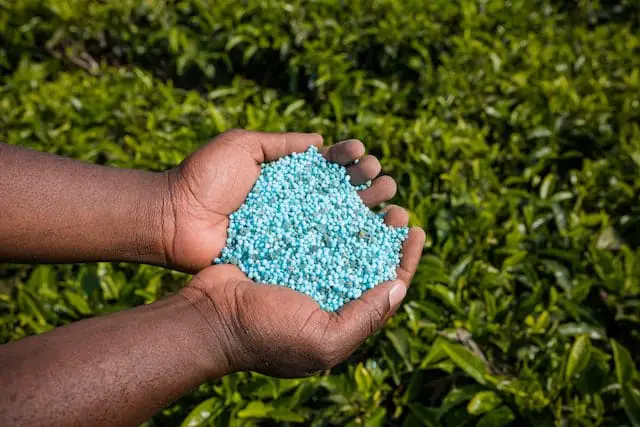
Prayer plants require regular feeding and fertilizing to maintain their health and promote growth. Use a balanced, water-soluble fertilizer once a month during the growing season. Be sure to follow the instructions on the package, and avoid over-fertilizing, which can damage the plant.
3. Monitoring Moisture Levels
Prayer plants require consistent moisture levels to thrive. Use a moisture meter to monitor the soil moisture level, and water the plant when the top inch of soil feels dry to the touch. Avoid overwatering, which can lead to root rot and other fungal diseases.
4. Providing Ideal Temperature and Environment
Prayer plants thrive in warm, humid environments. Keep the plant in a room with a temperature between 65-80°F (18-27°C), and maintain humidity levels between 40-60%. To increase humidity levels, place a tray of water near the plant, or use a humidifier.
Conclusion
The care guide for prayer plants is relatively simple. They require moderate watering, indirect sunlight, and high humidity. Overwatering, underwatering, and exposure to direct sunlight can all cause damage to the plant.
It is also important to avoid placing the plant near heating or cooling vents, as this can cause fluctuations in temperature and humidity.
Solutions for a dying prayer plant include adjusting the watering schedule, repotting the plant, and treating for pests or disease. Experimentation with different soil types, fertilizers, and watering methods may also be necessary to find the best solution for a specific plant.
Placement of the prayer plant is also crucial for its health and well-being. Placing it in a shady spot with indirect sunlight and high humidity is ideal. It is best to avoid placing it near heating or cooling vents, drafts, or areas with low humidity.
Frequently Asked Questions
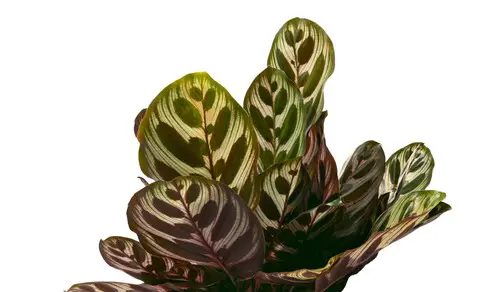
What are the signs of overwatering a prayer plant?
Overwatering can lead to root rot and other fungal diseases, which can be the end of your lovely plant. Signs of overwatering include yellowing leaves, mushy stems, and a foul smell coming from the soil.
How can I save an overwatered prayer plant?
To save an overwatered prayer plant, first, remove it from its pot and gently shake off the excess soil. Then, trim off any dead or mushy roots. Repot the plant in fresh, well-draining soil and reduce watering to once a week.
Why are the leaves of my prayer plant curling and turning brown?
Curling leaves and brown tips can be a sign of underwatering or low humidity. Make sure to water your prayer plant when the top inch of soil feels dry, and mist the leaves regularly to increase humidity.
How do I know if my prayer plant is dying?
A dying prayer plant may have yellowing leaves, mushy stems, or a foul smell coming from the soil. It may also have wilted or droopy leaves and stems.
What should I do with dead leaves on my prayer plant?
Dead leaves should be removed from your prayer plant to prevent the spread of disease. Use clean, sharp scissors to trim off the dead leaves at the base of the stem.
Will my prayer plant grow back if it’s dying?
If caught early enough, a dying prayer plant can be revived with proper care and attention. However, if the plant is severely damaged or has been dying for an extended period, it may not be able to recover.

Hey, I’m Lisa and I’ve been an avid gardener for over 30 years. I love writing, talking and living in the garden! Feel free to connect with me on my socials below


